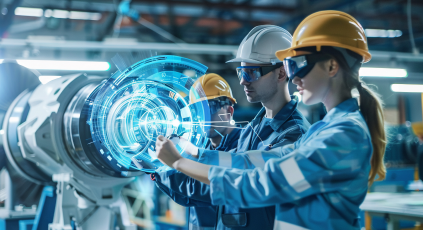Client
The client is a global leader in industrial equipment manufacturing with a well-established footprint in the elevator and escalator industry. With thousands of installations across North America and the UK, the company supports a wide range of customers—including residential complexes, commercial spaces, and institutional buildings, by ensuring safe, reliable, and efficient operations.
In recent years, increasing price sensitivity among customers led to higher churn rates, impacting revenue. Additionally, improving service efficiency became critical to maintaining profitability in a competitive landscape. To address these gaps, the client sought a proactive and predictive technology-driven approach to enhance maintenance, strengthen compliance, and improve overall customer experience.
Market Trends in Manufacturing and Service Industries
Manufacturers and service-based industries are embracing digital transformation to enhance efficiency and customer engagement. With increasing competition from local players, companies are focusing on value-added services to drive customer retention. At the same time, stricter government regulations are pushing businesses to improve safety, compliance, and operational transparency.
In asset-intensive sectors like elevators, IoT digital transformation is reshaping service models, enabling predictive maintenance and real-time monitoring. The aging workforce and skill shortages make AI-driven training and knowledge retention essential.
As the future of the elevator industry moves toward smarter, data-driven ecosystems, organizations must adopt intelligent solutions to stay ahead. LTIMindtree has been a trusted partner for manufacturers, leveraging AI, IoT, and cloud technologies to help organizations enhance service efficiency, meet compliance needs, and drive sustainable growth.

Challenges and Improvement Areas
- Missing out new contracts: Without IoT integration and predictive maintenance capabilities, companies risk losing potential clients who prioritize technology-driven service efficiency.
- Losing existing contracts: Price-sensitive customers are switching to competitors offering more cost-effective, tech-enabled service plans, leading to revenue loss.
- Fragmented digital interfaces: Customers currently navigate multiple disconnected systems to access elevator service, maintenance, and complaint resolution, leading to inefficiencies. A single unified platform is needed.
- Workforce readiness: The aging skilled workforce poses a risk as tribal knowledge is lost. AI-powered training and guidance can bridge the knowledge gap for new technicians.
- Passenger safety & experience: Ensuring continuous communication (voice, video, and text) in case of elevator malfunctions is becoming a regulatory necessity and a customer expectation.
- Compliance with safety regulations: Governments are enforcing strict real-time reporting requirements for system failures, demanding automated, IoT-enabled compliance reporting.
- Field productivity: Technicians face inefficiencies due to a lack of real-time access to service history, manuals, and troubleshooting guides, leading to longer issue resolution times.
Opportunities
Addressing these challenges opens several opportunities for enhanced efficiency, customer satisfaction, and new revenue streams:
These opportunities, when executed effectively, drive both operational efficiency and long-term business growth.
LTIMindtree Solution
The client partnered with LTIMindtree to develop a scalable digital innovation system that enhances efficiency and provides valuable insights across its global elevator and escalator network. The solution is structured into three key layers:
By the end of 2024, this solution was adopted globally, managing more than 600,000 elevators and escalators.
Business Benefits
The implementation of the AI-driven predictive maintenance system delivered significant business impact:
Fewer service interruptions
Predictive insights reduced service tickets by 10-15%, minimizing unplanned disruptions and enhancing customer satisfaction.
Optimized maintenance efficiency
AI-powered diagnostics lowered maintenance hours by 10-20%, enabling teams to work smarter and focus on critical tasks.
Expanded service portfolio
Improved reliability and data-driven offerings contributed to a 2-5% growth in service contracts, strengthening long-term customer relationships.
Increase in new equipment sales
The enhanced service experience and proactive recommendations led to a 2-5% rise in new equipment purchases.
Improved financial performance
Greater productivity, reduced inefficiencies, and optimized service operations translated into higher revenue and margins.
Quote
LTIMindtree has been a trusted partner from the start of this digital transformation journey. With strong thought leadership, innovative program management techniques, and a diverse skill set, we have played a key role in the development, deployment, and support of this transformative program. Our connected elevator solution drives tangible value for clients by enhancing customer engagement, increasing service revenue, and improving efficiency and profit margins.
Sameer Joshi, Sr. Engagement Partner, iNXT, LTIMindtree
Conclusion
The future of the elevator industry is being actively reshaped by AI, IoT, and data-driven intelligence. What began as a transformation of service operations continues to mature—now entering a new phase focused on enriching existing solutions and embedding deeper AI-driven insights for enhanced efficiency. This evolving partnership is rooted in long-term collaboration, with a shared commitment to co-creating value, strengthening predictive capabilities, and delivering sustained outcomes.











